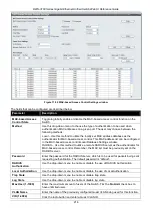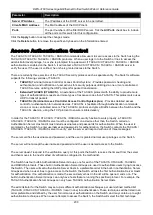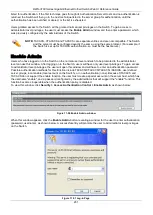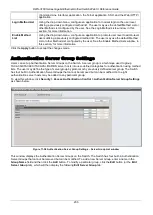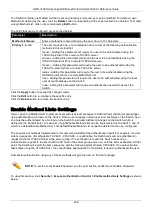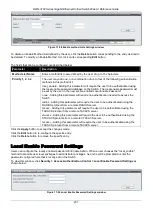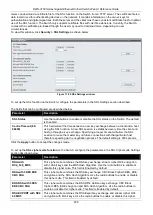
DWS-3160 Series Gigabit Ethernet Unified Switch Web UI Reference Guide
226
Loopback Detection port will restart (change to normal state) when the Loopback Detection
Recover Time times
out. The Loopback Detection function can be implemented on a range of ports at a time. The user may enable or
disable this function using the drop-down menu.
To view this window, click
Security > Loopback Detection Settings
as shown below:
Figure 11-45 Loopback Detection Settings window
The fields that can be configured are described below:
Parameter
Description
Loopback Detection
State
Use the radio button to enable or disable loopback detection. The default is
Disabled.
Mode
Use the drop-down menu to toggle between
Port-based
and
VLAN-based
.
Trap State
Set the desired trap status:
None
,
Loop Detected
,
Loop Cleared
, or
Both
.
Log State
Specifies the state of the log for loopback detection.
Interval (1-32767)
The time interval (in seconds) that the device will transmit all the CTP (Configuration
Test Protocol) packets to detect a loop-back event. The valid range is from
1
to
32767
seconds. The default setting is
10
seconds.
Recover Time (0 or 60-
1000000)
Time allowed (in seconds) for recovery when a Loopback is detected. The Loop-
detect Recover Time can be set at
0
seconds, or
60
to
1000000
seconds. Entering
0
will disable the Loop-detect Recover Time. The default is
60
seconds.
From Port / To Port
Use the drop-down menus to select a range of ports to be configured.
State
Use the drop-down menu to toggle between
Enabled
and
Disabled
.
Click the
Apply
button to accept the changes made for each individual section.
Traffic Segmentation Settings
Traffic segmentation is used to limit traffic flow from a single or group of ports, to a group of ports. This method of
segmenting the flow of traffic is similar to using VLANs to limit traffic, but is more restrictive. It provides a method of
directing traffic that does not increase the overhead of the master switch CPU.





